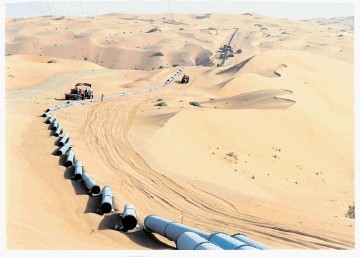
Saudi Arabia’s oil exports rose to a seven-month high in November when it led OPEC to keep production unchanged as the largest crude shipper fought to keep market share with output rising from the US to Russia.
Saudi Arabia’s oil exports rose to 7.3 million barrels a day from 6.9 million barrels in October, according to data yesterday on the website of the Joint Organisations Data Initiative.
Crude stockpiles at the end of the month stood at 305.8 million barrels, the highest level since at least January 2002, figures on the group’s website showed.
Saudi Arabia dropped its official selling prices in Asia for November sales to gain market share in the fastest-growing region for petroleum demand while it helped domestic refiners to be profitable.
Brent crude futures have dropped about 35% since the Organization of Petroleum Exporting Countries unexpectedly maintained its production target of 30 million barrels a day on November 27.
“The Saudis are trying to test the market with both higher volumes and lower prices,” John Sfakianakis, head of Ashmore Middle East, said from Riyadh.
“They are flooding the market with exports and storage while keeping the price of their crude competitive.
“These are signs that they will do all what they can to keep up the market share.”
Brent oil dropped 0.3% to $50 a barrel by 8:16 a.m. in Dubai, extending the decline to 53% in the past year.
Saudi Arabian Oil Minister Ali Al Naimi has asked why he should be responsible for cutting output while United Arab Emirates Energy Minister Suhail Al-Mazrouei said non-OPEC producers should reduce “irresponsible” production.
An increase of about 6 million barrels a day in supply from countries outside the group, including the US and Russia, helped trigger the drop in prices, according to OPEC Secretary-General Abdalla El-Badri.
Saudi Arabia’s production in November dropped to 9.61 million barrels a day from 9.69 million barrels in October, according to the Joint Organisation website.
Saudi Arabia wants to keep market share so it can maintain production of at least 9.6 million barrels a day, Sfakianakis said.
“The discounts Saudi Arabia gave in November helped a lot in selling crude that was freed during the month from domestic use,” Essam al-Marzooq, an independent energy analyst in Kuwait and former vice president for Europe at state-run Kuwait Petroleum International, said by phone from Kuwait City.
“Saudi Arabia doesn’t want to see its output go below 9.6 million barrels a day. This is a baseline and legitimate level the Saudis will not forgo.”
For more oil and gas news from the Middle East, click here.
Recommended for you
